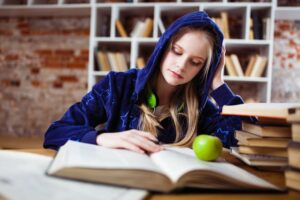Light, Refraction & Lenses
Discussion – Discuss your experience when standing in front of different types of mirrors in a fun house or even in a clothing store. Why do you look taller or shorter, narrower or wider, or distorted in other ways in these mirrors? Maybe you’ve even seen more than one of yourself in a set of mirrors. Describe your experience. Are these trick mirrors or applications of physics? Explain your answer.
Light Spectrum and Efficiency
You may have already used the Blackbody Spectrum simulation to see how the temperature of a substance affects how light is emitted. Many of the light sources you’re familiar with are incandescent light sources. They glow because they have a nonzero temperature. The hotter the source, the more radiant energy it gives off. Now, let’s explore a few different incandescent energy sources and investigate their lighting efficiency. In this simulation, the curve represents the radiation intensity and energy emitted with respect to the wavelength at a given temperature.
To begin, launch the Blackbody Spectrum https://contentstore.ple.platoweb.com/content/sharedmedia/Phet_Sims_upd/blackbody-spectrum/blackbody-spectrum_en.html 
Part A Light, Refraction & Lenses
Several different incandescent radiation sources are listed in the table below, along with their respective temperatures. Sunlight is provided as a baseline measurement at the top of the table. You will determine the peak intensity for each source with respect to its visible color spectrum. You also estimate the amount of emitted energy that falls in the visible light spectrum.
To do so
- drag the slider to reach the temperature listed in the first column of the table. You can also type in the temperature value in the text box above the temperature slider.
- use the buttons to zoom in or out on either the vertical or horizontal axis to easily observe the curve (and the peak). The peak should be as high as possible, while still being visible on screen. You should extend the scale far enough to the right to see the curve reach very close to zero emission on the right.
- estimate the percentage of emitted energy that appears to fall within the visible spectrum and enter that value in the table. You can do this by estimating the area under the energy curve in the visible region as compared to the total area under the curve.
Incandescent Light Sources Temperature(K) Color at the Peak of the Curve Energy in
Visible Spectrum
sunlight 5800
photoflood 3400
100-watt incandescent 2870
40-watt incandescent 2500
candle flame 1900
electric stovetop coil 800
10ptSpace used(includes formatting): 1474 / 30000
Part B
From the readings above, what can you say about the lighting efficiency of the various incandescent radiation sources? Which are the most efficient in emitting visible light?
Support your answer with suitable reasoning.
15pxSpace used(includes formatting): 0 / 30000
Part C
Compact fluorescent (CFL) bulbs provide about four times as much visible light for a given amount of energy use. For example, a 14-watt CFL bulb provides about the same amount of visible light as a 60-watt incandescent bulb. LED lights are even more efficient at turning electrical energy into visible light. Does that mean they are both a lot hotter? Go online and research how fluorescent and compact fluorescent bulbs work. Describe how their operations and their spectra differ from those of incandescent light bulbs. Be sure to record your research sources.
15pxSpace used(includes formatting): 0 / 30000
Refraction and Refractive Index
Question 1
In this activity, you will use the video measurement and analysis tool, Tracker, to observe how light is refracted when it travels between air and Acrylite, a transparent plastic material. You will also make observations and quantitative readings about the angle of incidence and angle of refraction to find the refractive index of Acrylite.
To begin your activity, open the Tracker experiment Acrylite to Air contentstore.ple.platoweb.com/content/sharedmedia/Tracker/applications/acrylite-to-air/acrylite-to-air.html .
Click play  to watch the video. The other video controls allow you to rewind
to watch the video. The other video controls allow you to rewind  the video or step forward
the video or step forward  or backward
or backward  one frame at a time.
one frame at a time.
Observe the video to proceed with the activity, in which you will collect data to calculate the refractive index of acrylite.
Part A
Describe your observations of light traveling from Acrylite into air in the video. Then, compare the relative refractive properties of Acrylite and air. Provide a rationale for any conclusions you may come to.
15pxSpace used(includes formatting): 0 / 30000 Light, Refraction & Lenses
Part B
Do you notice any peculiarity in the way the light ray behaves at large angles? Explain this behavior, based on your knowledge of refraction.
15pxSpace used(includes formatting): 0 / 30000
Part C
Now, grab Tracker’s protractor tool (the green angle in the video frame) and measure the angle of incidence and the angle of refraction for the frame numbers specified in the table below. Hints:
- To advance the video a frame at a time, use the step buttons on the right.
- Position the vertex of the protractor exactly at the origin of the coordinate axis.
- Move the arms of the protractor so that one arm is on the vertical axis (above or below, as appropriate) and the other on the light ray.
Frame Number Angle of Incidence (θi) in Degrees Angle of Refraction (θr) in Degrees 8
10
12
14
16
18
10ptSpace used(includes formatting): 634 / 30000
Part D
The light ray is traveling from Acrylite into air. The refractive index for air is 1.00. If the angle of incidence and the angle of refraction are known, how could you determine the refractive index of Acrylite?
15pxSpace used(includes formatting): 0 / 30000
Part E
Using the angles of incidence and angles of refraction obtained in question 4, complete the rest of the table below, entering sine values and calculating the refractive index of acrylite for each angle measured. Finally, average these values and enter your calculated average value for the refractive index of acrylite in the space below.
10ptSpace used(includes formatting): 2061 / 30000
Part F
Conduct online research to find the refractive index of Acrylite, the material used in the Tracker experiment. (Acrylite is also known as Acrylite glass, or PMMA.) Does the average refractive index you calculated match the accepted refractive index for Acrylite?
15pxSpace used(includes formatting): 0 / 30000
Question 2
Now, open the second Tracker experiment, Air to Acrylite contentstore.ple.platoweb.com/content/sharedmedia/Tracker/applications/air-to-acrylite/air-to-acrylite.html .
Click play  to watch the video. The other video controls allow you to rewind
to watch the video. The other video controls allow you to rewind  the video or step forward
the video or step forward  or backward
or backward  one frame at a time.
one frame at a time.
Observe the video to proceed with the activity. In this activity too, you will collect data to calculate the refractive index of acrylite.
Part A
What do you see in this video? Do these observations support your previous findings regarding refractive properties of Acrylite as compared to air? Provide a rationale for your answer.
15pxSpace used(includes formatting): 0 / 30000
Part B
Now, follow the same procedure you did in the earlier Tracker experiment. Find the angle of incidence and the angle of refraction for the frame numbers specified in the table below. Then, calculate the refractive index for Acrylite for this new data. Make a calculation for each measurement in the table. Finally, enter the average of these values in the space below the table.
Frame Number Angle of Incidence (θi) in Degrees Angle of Refraction (θr) in Degrees
Sine θi Sine θr Refractive Index
15
20
25
30
35
40
43
10ptSpace used(includes formatting): 2333 / 30000
Part C
After researching the actual refractive index of Acrylite on the Web, did you find that it matches your calculations?
15pxSpace used(includes formatting): 0 / 30000
Applications of Convex and Concave Lens
In this activity, you will revisit the two videos about how light is refracted when incident on a lens. First, open the convex lens video. Observe how the light rays parallel to the principal axis behave when they hit the convex lens at different points. You can replay the video any time during this activity.
Then, watch the second concave lens video. Observe how the light rays parallel to the principal axis behave when they hit the lens at different points. You can replay the video any time during this activity.
livephoto.sciencetutorials.net//LPVideos/refl-refr/concave_lens.mp4
Part A
Describe what happens to the incoming parallel rays for the two lenses. Compare and contrast the results.
15pxSpace used(includes formatting): 0 / 30000
Part B
Below is a list of some applications of lenses. Determine which lens could be used in each and explain why it would work. You can conduct online research to help you in this activity, if you wish.
Applications Lens Used Reason
peephole in a door
objective lens (front lens) of binoculars
photodiode – In a garage door or burglar alarm, it can sense the light (or the lack of it) from an LED light source positioned some distance away.
magnifying glass
viewfinder of a simple camera
10ptSpace used(includes formatting): 709 / 30000
Part C
A human eye is a convex lens. In normal eyesight, the image of an object in front of our eyes is formed exactly on the retina and is inverted. In farsighted and nearsighted eyesight, where is the image formed? Which lens can be use as a corrective measure in each case? You may use online or other resources to help you answer this question. Be sure to record your research sources in the References section near the end of this document.
-
Why do mirrors in fun houses make us look distorted? Are they trick mirrors or applications of physics?,
-
From the Blackbody Spectrum activity which incandescent sources are most efficient in emitting visible light? Why?,
-
How do CFL and LED bulbs differ from incandescent bulbs in operation and spectra?,
-
Based on Tracker experiments what is the refractive index of Acrylite compared to air? Do experimental values match accepted values?,
-
What happens to parallel rays in convex and concave lenses and how are these lenses applied in everyday life (e.g., glasses, cameras, peepholes)?





